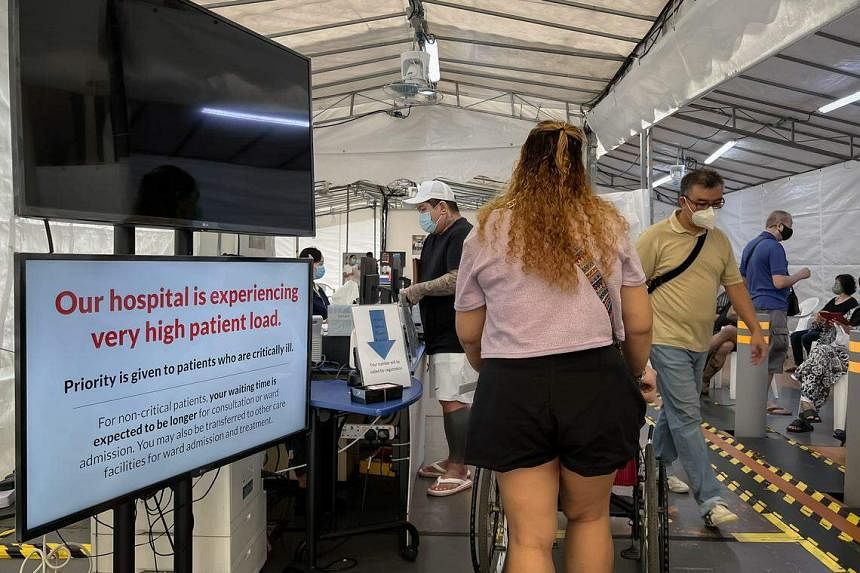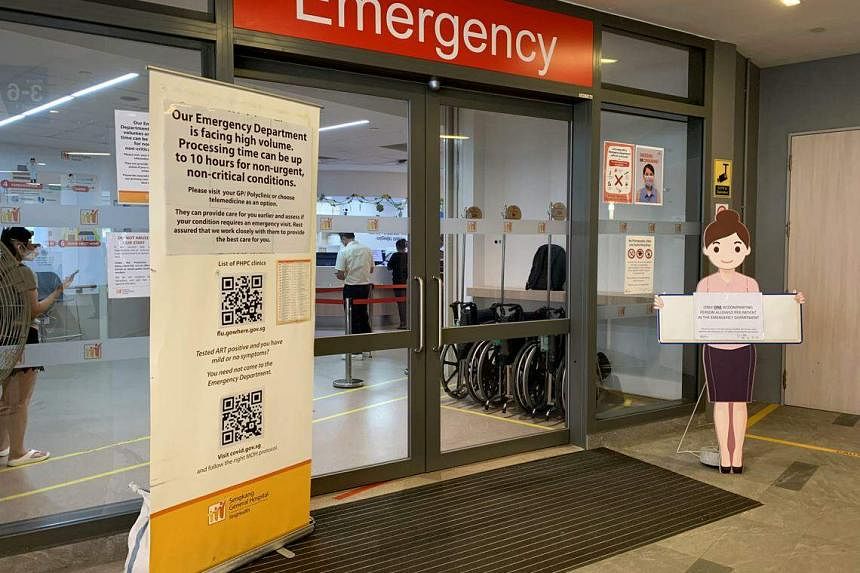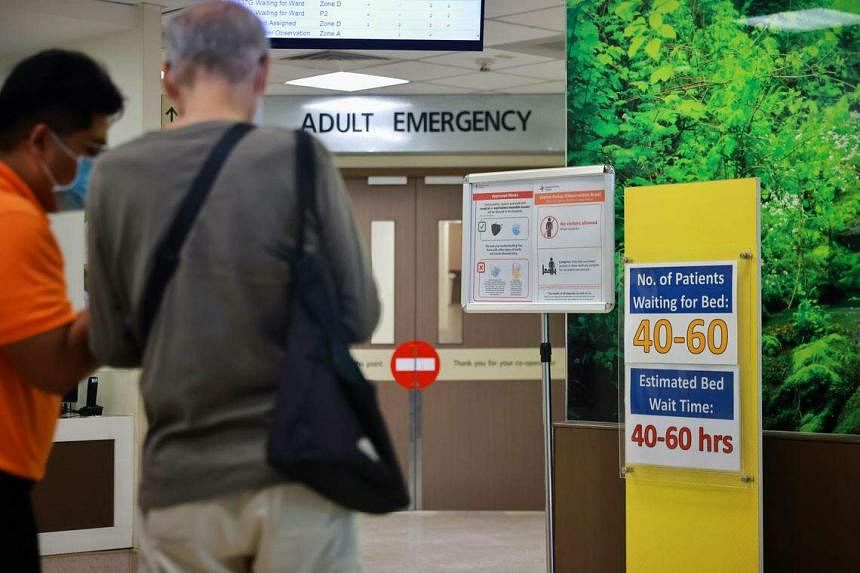SINGAPORE – Patients needing hospitalisation are waiting longer to get a bed due to a high number of patients, many with complex conditions. But the Ministry of Health (MOH) stressed that treatment begins even as they wait to get sent to a ward.
The recent surge in Covid-19 cases has added to the shortage of beds, MOH said on Friday.
The median wait time has gone up over the past fortnight, from five hours to 7.2 hours, the ministry said.
A check by The Straits Times found that in some cases, patients can wait up to four days to get a bed.
An MOH spokesman said hospitals have been seeing a high volume of non-Covid-19 patients, and also more Covid-19 patients.
Citing Health Minister Ong Ye Kung, who spoke in Parliament on March 21, the spokesman said: “We have many more patients with more complex medical needs, often older ones, who needed longer hospital stays.
“This contributed to higher bed utilisation, which slowed the flow of patients from emergency departments (EDs) to hospital wards. Ultimately, the situation has to be resolved with more hospital capacity, the development of which has been delayed due to Covid-19.”
The spokesman said the ministry has been expanding transitional care facilities where medically stable patients can be moved to from hospitals prior to their discharge.
He also gave the assurance that medical teams will start treatment for patients while they wait for a bed in the ward.
At places like Alexandra Hospital, waiting for three hours was the norm in the week of April 9. Singapore’s biggest hospital, the Singapore General Hospital, also had median wait times ranging from 3.3 hours to 8.5 hours that week. But other hospitals had days when half of the patients needed more than 25 hours to get a bed.
The worst hit appears to be Khoo Teck Puat Hospital (KTPH), which in the three weeks to April 15 had 16 days when the wait for a bed was more than 20 hours. The longest median wait was 40 hours on March 27.
KTPH recorded 100 per cent bed occupancy for six days in the same week, with 95.7 per cent occupancy on the remaining day. On April 10, half of its patients waited more than 29 hours for a bed.
The son of a patient said his father, who suffers from multiple conditions, waited more than four days to move from the emergency department to a ward.
Professor Chua Hong Choon, chief executive of KTPH and Yishun Health, admitted that the hospital has been experiencing heavy patient loads for the past few months, and that its staff have been working longer hours to ensure that patients are cared for.
But he said there are “unique and extraneous factors” that contributed to the long waiting times for a bed, including the delay in the opening of Woodlands Health. Demand for beds in the northern part of the country has increased and is expected to grow.
Prof Chua added: “We are seeing more ill patients than before, coming to our ED via ambulances, and presenting with complex conditions and comorbidities. As a result, the average length of stay of our patients has increased, and those in the ED have to wait longer for beds to be made available.”

The hospital has expanded its ED to hold more patients, and redeployed staff to care for these patients while they wait for a bed. Trolley beds have been added in wards “so that patients can start receiving treatment without delay”, the spokesman said. The hospital is increasing its home support so that patients can be discharged earlier.
Meanwhile, the National University Hospital (NUH) and Ng Teng Fong General Hospital (NTFGH) have put up signs at their EDs to inform patients that they could wait up to 60 hours for a bed. At one point this week, NUH said there were 80 patients in the queue for beds.
The latest data from MOH is for the week of April 9. That week, these two hospitals had bed occupancy rates in the high 80 per cent or low 90 per cent, but they were not even the hospitals that were the worst hit.
Changi General Hospital (CGH) posted a notice on its Facebook page on Tuesday saying: “We are seeing a high number of patients at our emergency department, and waiting times will be longer. Priority of care will be given to patients with serious or life-threatening conditions.”
The hospital has six holding rooms for patients who have been admitted but have yet to be assigned a ward.
A spokesman for Sengkang General Hospital (SKH) – which on its worst day on April 11 was able to find beds for half its patients within 26.9 hours – said patients are started on their treatment plan while waiting for a bed in the ED.
“The speciality doctor from the inpatient team will review, assess and plan the treatment for patients without waiting for the patient to be transferred to the ward,” she said.
An ED doctor said the real problem lies in the shortage of manpower, rather than a lack of beds. Many foreign nurses returned home after the pandemic and did not come back. If there were more qualified staff, more wards could be opened.

To mitigate the crunch, some hospitals are reducing the number of non-emergency treatments to save beds for more critical cases.
Professor Terrance Chua, group chairman of the medical board of the SingHealth cluster, said its hospitals – Singapore General Hospital, CGH and SKH – will assess and, if necessary, defer non-urgent procedures to free up beds for those who are more critically ill.
He said these non-urgent cases will proceed only “when it is clinically assessed by our medical teams to be safe to do so, without compromise to patient safety or interruption to urgent care”.
A spokesman for the National University Health System (NUHS), which runs both NUH and NTFGH, said it has added more inpatient beds. It is also transferring patients from these two hospitals to Alexandra Hospital (AH), which is part of the cluster.
The spokesman said: “As an integrated system, NUHS has an overall view of real-time capacity and patient load across the hospitals. As part of a cross-cluster effort, AH has stepped up on taking in patients from NUH and NTFGH to manage the high patient load, accepting transfer patients daily from NUH and NTFGH.”
In spite of these efforts, the waiting time for a bed can still be days, offering little respite since the situation was raised in October 2022.
At the time, all three hospital clusters said they were working with MOH to reduce the time it takes for patients to get a bed. The third cluster is the National Healthcare Group, which runs KTPH and Tan Tock Seng Hospital.
Not only was there a bed crunch then, some EDs were so full that patients arriving by ambulance sometimes could not be taken inside. In fact, there were occasions when the medical team had to assess the patient as he lay on the ambulance trolley, for lack of beds in the emergency room.
The situation should improve towards the end of the year, when Woodlands Health opens.

